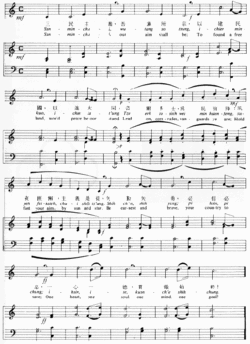San Min Chu-i
|
三民主義 San Min Chu-i |
|
|---|---|
| transcription | Sānmín Zhǔyì |
| Alternative title | 三民主义 |
| Title in German | Three principles of the people |
| country |
|
| Usage period | de facto from 1937, de jure from 1943 |
| text | Hu Hanmin , Dai Jitao , Liao Zhongkai , Shao Yuanchong |
| melody | Cheng Maoyun |
| Sheet of music |

|
| Audio files | |
San Min Chu-i ( Chinese 三民主義 / 三民主义 , Pinyin Sānmín Zhǔyì ) is the national anthem of the Republic of China , whose national territory is now limited to Taiwan . The title translated means Three Principles of the People and refers to the national ideology of the Republic of China developed by Sun Yat-sen . The principles are State Socialism / People's Welfare ( Chinese 民生 主義 / 民生 主义 , Pinyin Mínshēng Zhǔyì ), Democracy / People's Law ( Chinese 民權 主義 / 民权 主义 , Pinyin Mínquán Zhǔyì ) and Nationalism / People's Community ( Chinese 民族 主義 / 民族 主义 , Pinyin Mínzú Zhǔyì ). The song stands for the visions and hopes of a new nation and its people. It is also the Kuomintang party song .
The anthem is banned in mainland China, and public performance is strongly discouraged in Hong Kong, although it is not officially banned there. When President Chen Shui-bian took office in Taiwan in 2000 , the well-known singer A-Mei Chang sang the anthem. This led to her being banned from appearing in the People's Republic of China for several months .
History of origin
The text of San Min Chu-i was created by the collaboration of four Kuomintang members: Hu Hanmin ( 胡漢民 ), Dai Jitao ( 戴季陶 ), Liao Zhongkai ( 廖仲愷 ) and Shao Yuanchong ( 邵元 沖 ).
The text was first presented on July 16, 1924, during Sun Yat-sen's opening speech at the opening of the Whampoa Military Academy .
After the success of the northern campaign , the KMT decided to use the text as a party anthem and therefore publicly asked for suggestions for musical accompaniment. The melody of Cheng Mao-yun ( 程 懋 筠 ) won the competition from among 139 participants.
On March 24, 1930, several KMT party members suggested that San Min Chu-i be declared the official national anthem. However, there was a strong opposition that was against a party symbol representing the whole country. Therefore the committee for research and preparation of the national anthem ( 國歌 編製 研究 委員會 / 国歌 编制 研究 委员会 , Guógē Biānzhì Yánjiū Wěiyuánhuì ) was founded. However, this advocated the proposal to use the party song as the national anthem. On June 3, 1937 , the Central Office ( 中央 常務委員會 / 中央 常务委员会 , Zhōngyáng Chángwù Wěiyuánhuì ) confirmed the proposal, and in 1943 San Min Chu-i became the official national anthem of the Republic of China.
San Min Chu-i was voted the world's best national anthem at the 1936 Summer Olympics .
text
| Chinese | translation | |
|---|---|---|
|
三民主義 , 吾 黨 所 宗 , |
Sānmín Zhǔyì, wú dǎng suǒ zōng, |
The three popular principles, the goal of our party. |
National Anthem of the Republic of China (Taiwan)
See also
Web links
- Audio stream of the national anthem of the Republic of China ( WMA ; 2.8 MB)
- Office of the President of the Republic of China - National Symbols, accessed October 10, 2019
Individual evidence
- ↑ Kwan Kim-Gaul: Dragon Throne and Blue Ants . Limes Verlag, Wiesbaden 1965.
- ↑ National Symbols: National Anthem. Office of the President of the Republic of China (Taiwan), accessed November 11, 2018 .
- ^ Government Information Office Republic of China: The Republic of China Yearbook 1993 p. 685
